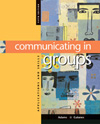 |  Communicating in Groups: Applications and Skills, 5/e Katherine L. Adams,
California State University Fresno
Gloria J. Galanes,
Southwest Missouri State University
Creative and Critical Thinking in the Small Group
Learning ObjectivesAfter reading this chapter you should be able to:
Define creative thinking and explain why it is important to small group problem solving. |
 |  |  | Describe both brainstorming and synectics and explain how they can be used to help enhance group creativity. |
 |  |  | Define critical thinking and explain why it is important to small group problem solving. |
 |  |  | List and describe the attitudes most conducive to critical thinking in a group. |
 |  |  | Explain how group members should use critical thinking during the information gathering stage of problem solving. |
 |  |  | Describe and give examples of each of the five steps crucial to evaluating information. |
 |  |  | Define and give examples of each of the five reasoning errors described in the text: overgeneralizing, attacking a person instead of the argument, confusing causal relationships, either-or thinking, and incomplete comparisons. |
 |  |  | Give examples of probing questions critical thinkers should ask when they evaluate information. |
|



 2003 McGraw-Hill Higher Education
2003 McGraw-Hill Higher Education